Themed collection Nanoscale and Nanoscale Horizons: Carbon-based nanomaterials

Recent advances in metal–organic framework/carbon nanotube nanocomposites for developing analytical applications
Modifying sensors and sorbents made of MOF–CNT nanocomposites can enhance analyte detection in various analytical techniques.

Nanoscale, 2023,15, 11457-11465
https://doi.org/10.1039/D3NR01074K
Recent advances in aggregation-induced emission materials for enhancing solar energy utilization
We summarized the recent progress of aggregation-induced emission (AIE) materials in luminescent solar concentrators, photosynthesis augmentation and solar steam generation. The luminescence and heat generation of AIE materials in different states have been utilized.

Nanoscale Horiz., 2023,8, 453-459
https://doi.org/10.1039/D2NH00506A
Conjugated nanomaterials for solar fuel production
Photocatalytic hydrogen production from water has the potential to fulfil future energy needs by producing a clean and storable fuel. Here the discuss the recent advances in using nanosized materials as photocatalysts.
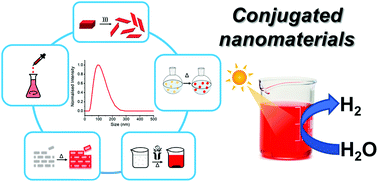
Nanoscale, 2021,13, 634-646
https://doi.org/10.1039/D0NR07533G
Enhancing electrochemical sensing through the use of functionalized graphene composites as nanozymes
+ Different categories of artificial enzymes (nanozymes) according to the type of graphene derivative.

Nanoscale, 2023,15, 16514-16538
https://doi.org/10.1039/D3NR01998E
Recent advances in carbon dots: synthesis and applications in bone tissue engineering
The synthesis and applications of carbon dots in osteogenesis, fluorescence tracing, phototherapy and antibacterial activity have been explored.

Nanoscale, 2023,15, 3106-3119
https://doi.org/10.1039/D2NR05951G
Synthetic carbon nanomaterials for electrochemical energy conversion
We summarize the key progress in the synthesis strategies of carbon nanomaterials and the underlying relationship between their atomic/molecular structure and electrocatalytic performance.

Nanoscale, 2022,14, 13473-13489
https://doi.org/10.1039/D2NR03865J
Polysaccharide-based nanocomposites for biomedical applications: a critical review
Polysaccharides (PSA) have taken specific position among biomaterials for advanced applications in medicine.
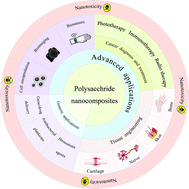
Nanoscale Horiz., 2022,7, 1136-1160
https://doi.org/10.1039/D2NH00214K
Progress in the use of organic potassium salts for the synthesis of porous carbon nanomaterials: microstructure engineering for advanced supercapacitors
Multifunctional organic potassium salts in the synthesis of porous carbon nanomaterials are elucidated and constructive viewpoints are provided for the cost-effective and molecular level engineering of porous carbon nanomaterials for supercapacitors.
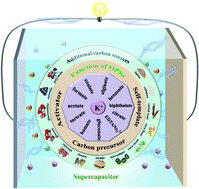
Nanoscale, 2022,14, 8216-8244
https://doi.org/10.1039/D2NR01986H
When graphene meets ionic liquids: a good match for the design of functional materials
Thanks to successful cohabitation between graphene and ionic liquids (ILs), a large avenue can be opened for the design of functional nanomaterials in a broad range of applications, including catalysis, gas separation and electrochemistry.
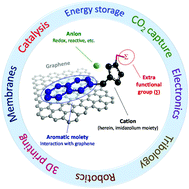
Nanoscale, 2021,13, 2750-2779
https://doi.org/10.1039/D0NR06871C
Covalent functionalization of carbon materials with redox-active organic molecules for energy storage
Carbon-based materials (CBMs) have shown great versatility because they can be chemically combined with other materials for various applications.

Nanoscale, 2021,13, 36-50
https://doi.org/10.1039/D0NR07500K
Carrier density and delocalization signatures in doped carbon nanotubes from quantitative magnetic resonance
Molecular charge transfer doping affords widely tunable carrier density and conductivity in s-SWCNTs (and OSCs in general), however, a pervasive challenge for such systems is reliable measurement of charge carrier density and mobility.

Nanoscale Horiz., 2024,9, 278-284
https://doi.org/10.1039/D3NH00480E
An anomalous Hall effect in edge-bonded monolayer graphene
In this article, we present an anomalous Hall effect in edge-bonded monolayer graphene.

Nanoscale Horiz., 2023,8, 1235-1242
https://doi.org/10.1039/D3NH00233K
Graphene foam membranes with tunable pore size for next-generation reverse osmosis water desalination
The development of carbon-based reverse osmosis membranes for water desalination is hindered by challenges in achieving a high pore density and controlling the pore size.
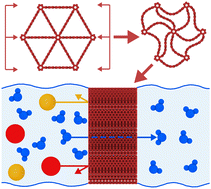
Nanoscale Horiz., 2023,8, 1082-1089
https://doi.org/10.1039/D2NH00475E
C3N2: the missing part of highly stable porous graphitic carbon nitride semiconductors
With two suitable organic units (TAPA and HADQ), H-C3N2 and T-C3N2 are designed and proposed based on the high possibility for experimental realization. They show different structural features and exceptional optoelectronic properties.

Nanoscale Horiz., 2023,8, 662-673
https://doi.org/10.1039/D2NH00440B
Understanding the partitioning behavior of single-walled carbon nanotubes using an aqueous two-phase extraction system composed of non-ionic surfactants and polymers
In this work, we decipher the mechanism of the aqueous two-phase extraction (ATPE) method, which has considerable application potential for purifying many types of nanomaterials.
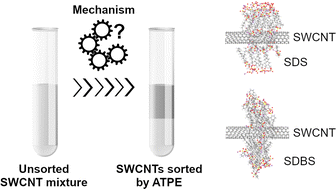
Nanoscale Horiz., 2023,8, 685-694
https://doi.org/10.1039/D3NH00023K
Unveiling the formation mechanism of the biphenylene network
We have computationally studied the formation mechanism of the biphenylene network via the intermolecular HF zipping, as well as identified key intermediates experimentally, on the Au(111) surface.
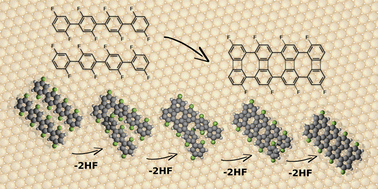
Nanoscale Horiz., 2023,8, 368-376
https://doi.org/10.1039/D2NH00528J
Thermodynamic mechanism of controllable growth of two-dimensional uniformly ordered boron-doped graphene
The thermodynamic mechanisms as well as the optimal experimental parameters of controllable growth of 2D uniformly ordered boron-doped graphene have been proposed by establishing the substrate-mediated phase diagrams.

Nanoscale Horiz., 2023,8, 346-352
https://doi.org/10.1039/D2NH00507G
Boosting efficiency of luminescent solar concentrators using ultra-bright carbon dots with large Stokes shift
Novel yellow emissive carbon dots (CDs) with a large Stokes shift are synthesized. The CDs can be employed to fabricate high-performance large-area luminescent solar concentrators due to successful suppression of reabsorption losses.

Nanoscale Horiz., 2023,8, 83-94
https://doi.org/10.1039/D2NH00360K
Electrical conductivity of a single parallel contact between carbon nanotubes
In situ measurements of the electrical resistance of a parallel contact between carbon nanotubes were performed. The electrical conductivities of individual nanotubes and the interface were derived by varying the contact length systematically.

Nanoscale, 2022,14, 11529-11534
https://doi.org/10.1039/D2NR04112J
Controlled formation of carbon nanotubes incorporated ceramic composite granules by electrostatic integrated nano-assembly
Controlled formation of CNT–Al2O3–ZrO2 composite granules by an electrostatic integrated nano-assembly method.
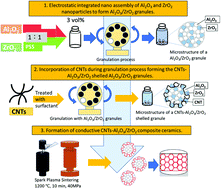
Nanoscale, 2022,14, 9669-9674
https://doi.org/10.1039/D2NR01713J
Magnetoconductance modulations due to interlayer tunneling in radial superlattices
We prove, in the first theoretical model, that unique boundary conditions and interlayer tunneling dominate the nature of electronic states in radial superlattices, leading to strongly momentum-dependent magnetoconductance modulations.
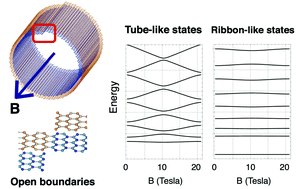
Nanoscale Horiz., 2022,7, 168-173
https://doi.org/10.1039/D1NH00449B
Controlled covalent functionalization of a graphene-channel of a field effect transistor as an ideal platform for (bio)sensing applications
Electrochemical grafting of a protected ethynylphenyl diazonium salt leads to the deposition of a functional monolayer on the graphene channel of a field effect transistor, leading to a general platform for (bio)sensing applications.
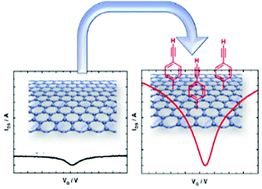
Nanoscale Horiz., 2021,6, 819-829
https://doi.org/10.1039/D1NH00355K
Carbon quantum dots as a dual platform for the inhibition and light-based destruction of collagen fibers: implications for the treatment of eye floaters
Fibrillation of collagen I is prevented most strongly by positively charged CQDs and pulsed-laser illumination destroys collagen aggregates and vitreous opacities.
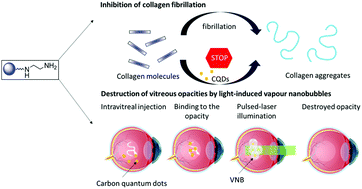
Nanoscale Horiz., 2021,6, 449-461
https://doi.org/10.1039/D1NH00157D
All-graphene-based open fluidics for pumpless, small-scale fluid transport via laser-controlled wettability patterning
We present an all-graphene based open microfluidic manufacturing technique by manipulating the surface wettability of spin-coated graphene ink films via laser-controlled patterning. The approach is rapid, flexible, and opens diverse applications in fluid transport.

Nanoscale Horiz., 2021,6, 24-32
https://doi.org/10.1039/D0NH00376J
Advancing mesoporous carbon synthesis for supercapacitors: a systematic investigation of cross-linking agent effects on pore structure and functionality
Advancing templating synthesis of mesoporous carbons for supercapacitors by investigating the cross-linking agent effect.

Nanoscale, 2023,15, 19658-19670
https://doi.org/10.1039/D3NR03244B
Unraveling the role of substrate materials in governing the carbon/carbide growth of molten carbonate electrolysis of CO2
The relationship between carbon-binding ability of metals and carbon/carbide growth on molten salts CO2 electrolysis is revealed.

Nanoscale, 2023,15, 18707-18715
https://doi.org/10.1039/D3NR03702A
Carbon dots-functionalized extended gate organic field effect transistor-based biosensors for low abundance proteins
Leveraging the ease of synthesis and modifiability of nanomaterial carbon dots, efficient immobilization of low-abundance proteins was achieved through covalent interactions, without compromising the device's performance.

Nanoscale, 2023,15, 16458-16465
https://doi.org/10.1039/D3NR03405D
Carbon nanowires made by the insertion-and-fusion method toward carbon–hydrogen nanoelectronics
Carbon nanowires can be made via the insertion-and-fusion of short carbon chains inside carbon nanotubes, and carry H adatoms that can tune the electronic and magnetic properties of carbon chains upon the varied H positions in C–H nanoelectronics.
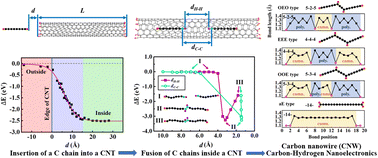
Nanoscale, 2023,15, 6143-6155
https://doi.org/10.1039/D3NR00386H
Large area roll-to-roll printed semiconducting carbon nanotube thin films for flexible carbon-based electronics
A universal roll-to-roll printing approach was developed to achieve large area semiconducting carbon nanotube thin films on flexible substrates, and printed flexible carbon-based electronics exhibited good electrical properties.

Nanoscale, 2023,15, 5317-5326
https://doi.org/10.1039/D2NR07209B
Nitrogen- and sulfur-doped graphene quantum dots for chemiluminescence
Chemiluminescence (CL) of NS-GQDs in the presence of CPPO and H2O2 was discovered to be a concerted process of intrinsic structure, AIE and surface state emissions by means of spooling CL spectroscopy and absolute CL efficiency measurements.

Nanoscale, 2023,15, 3864-3871
https://doi.org/10.1039/D2NR07213K
Coenzyme corona formation on carbon nanotubes leads to disruption of the redox balance in metabolic reactions
Carbon nanotubes (CNTs) have adverse impacts on metabolism in biological systems.
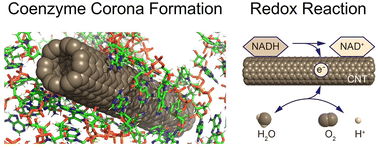
Nanoscale, 2023,15, 2340-2353
https://doi.org/10.1039/D2NR05213J
Ionic liquid-assisted synthesis of mesoporous polymers and carbon materials: the self-assembly mechanism
Soft-templating synthesis has been widely employed to fabricate ordered mesoporous polymer and carbon materials with effectively tuneable pore sizes.

Nanoscale, 2022,14, 14212-14222
https://doi.org/10.1039/D2NR02875A
Enhancement of lattice dynamics by an azimuthal surface plasmon on the femtosecond time scale in multi-walled carbon nanotubes
Surface plasmon-enhanced interlayer contraction on the femtosecond time scale was found in multi-walled carbon nanotubes by ultrafast transmission electron microscopy.

Nanoscale, 2022,14, 10477-10482
https://doi.org/10.1039/D2NR01272C
Towards custom built double core carbon nanothreads using stilbene and pseudo-stilbene type systems
Double diamond-like wires connected through chromophores which define the electronic properties have been synthesized compressing in a diamond anvil cell crystalline members of the stilbene class.
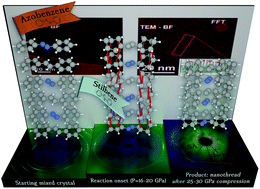
Nanoscale, 2022,14, 4614-4625
https://doi.org/10.1039/D1NR08188H
Electrical and thermal stimulus-responsive nanocarbon-based 3D hydrogel sponge for switchable drug delivery
The CNT sponge-based 3D frame hydrogel showed remarkable responses to electrical and thermal stimuli, exhibited excellent controllable/switchable drug delivery, and has great potential in biomedical engineering and medicine applications.

Nanoscale, 2022,14, 2367-2382
https://doi.org/10.1039/D1NR06074K
An electrochemically reduced ultra-high mass loading three-dimensional carbon nanofiber network: a high energy density symmetric supercapacitor with a reproducible and stable cell voltage of 2.0 V
Thickness and mass-dependent free-standing, highly conductive Na+-LBL 3D-CNF electrodes were fabricated via multi-step fabrication techniques for high-performance symmetric supercapacitors.

Nanoscale, 2021,13, 19537-19548
https://doi.org/10.1039/D1NR05943B
Hollow carbon nanospheres dotted with Gd–Fe nanoparticles for magnetic resonance and photoacoustic imaging
Hollow carbon nanospheres (HCSs) dotted with Gd–Fe nanoparticles are prepared and studied, which show enhanced photothermal conversion performance as well as integrated properties of photoacoustic and magnetic resonance imaging.

Nanoscale, 2021,13, 10943-10952
https://doi.org/10.1039/D1NR02914B
The formation mechanism and chirality evolution of chiral carbon dots prepared via radical assisted synthesis at room temperature
Cysteine-based chiral carbon dots (CDs) were prepared via room temperature radical assisted synthesis. These investigations pave the way for novel synthetic strategies for production of CDs with high control of the chirality.
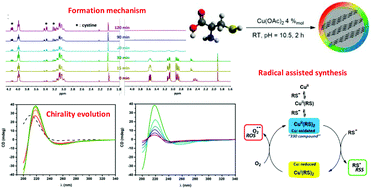
Nanoscale, 2021,13, 10478-10489
https://doi.org/10.1039/D1NR01927A
Realizing the large current field emission characteristics of single vertical few-layer graphene by constructing a lateral graphite heat dissipation interface
An in situ TEM result showed that a vertical few-layer graphene field emitter can carry large emission current at high temperature, benefiting from a graphite layer at the substrate interface which helps to efficiently dissipate heat during field emission.

Nanoscale, 2021,13, 5234-5242
https://doi.org/10.1039/D0NR09231B
Water-soluble green-emitting carbon nanodots with enhanced thermal stability for biological applications
Water soluble and thermally stable green emitting CNDs are prepared via a hydrothermal method. The as-obtained CNDs demostrate stable performance in T-ca cells at high temperatures.
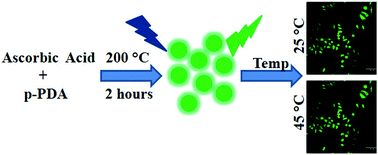
Nanoscale, 2021,13, 4301-4307
https://doi.org/10.1039/D0NR09131F
About this collection
This online collection from Nanoscale and Nanoscale Horizons showcases some of the recent carbon-based nanomaterials papers published in the journals.
We hope you enjoy reading these articles!